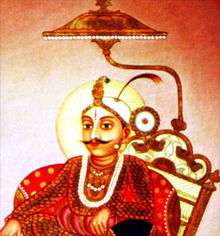Kanthirava Narasaraja II
| Kanthirava Narasaraja II | |
|---|---|
| Wodeyar of Mysore | |
 | |
| Reign | 1704 - 1714 |
| Predecessor | Chikka Devaraja |
| Born | 1673 |
| Died | 1714 |
| House | Wodeyar |
| Father | Chikka Devaraja |
| Mother | Devajammanni |
| Mysore Kings (1399–present) | |
| Feudatory Monarchy (As vassals of Vijayanagara Empire) (1399–1553) | |
| Yaduraya Wodeyar | (1399–1423) |
| Chamaraja Wodeyar I | (1423–1459) |
| Timmaraja Wodeyar I | (1459–1478) |
| Chamaraja Wodeyar II | (1478–1513) |
| Chamaraja Wodeyar III | (1513–1553) |
| Absolute Monarchy (Independent Wodeyar Kings) (1553–1761) | |
| Timmaraja Wodeyar II | (1553–1572) |
| Chamaraja Wodeyar IV | (1572–1576) |
| Chamaraja Wodeyar V | (1576–1578) |
| Raja Wodeyar I | (1578–1617) |
| Chamaraja Wodeyar VI | (1617–1637) |
| Raja Wodeyar II | (1637–1638) |
| Narasaraja Wodeyar I | (1638–1659) |
| Dodda Devaraja Wodeyar | (1659–1673) |
| Chikka Devaraja Wodeyar | (1673–1704) |
| Narasaraja Wodeyar II | (1704–1714) |
| Krishnaraja Wodeyar I | (1714–1732) |
| Chamaraja Wodeyar VII | (1732–1734) |
| Krishnaraja Wodeyar II | (1734–1761) |
| Puppetry Monarchy (Under Haider Ali and Tipu Sultan) (1761–1799) | |
| Krishnaraja Wodeyar II | (1761–1766) |
| Nanjaraja Wodeyar | (1766–1770) |
| Chamaraja Wodeyar VIII | (1770–1776) |
| Chamaraja Wodeyar IX | (1776–1796) |
| Puppetry Monarchy (Under British Rule) (1799–1831) | |
| Krishnaraja Wodeyar III | (1799–1831) |
| Titular Monarchy (Monarchy abolished) (1831–1881) | |
| Krishnaraja Wodeyar III | (1831–1868) |
| Chamaraja Wodeyar X | (1868–1881) |
| Absolute Monarchy Monarchy restored (As allies of the British Crown) (1881–1947) | |
| Chamaraja Wodeyar X | (1881–1894) |
| Krishnaraja Wodeyar IV | (1894–1940) |
| Jayachamaraja Wodeyar | (1940–1947) |
| Constitutional Monarchy (In Dominion of India) (1947–1950) | |
| Jayachamaraja Wodeyar | (1947–1950) |
| Titular Monarchy (Monarchy abolished) (1950–present) | |
| Jayachamaraja Wodeyar | (1950–1974) |
| Srikanta Wodeyar | (1974–2013) |
| Yaduveera Chamaraja Wadiyar | (2015–present) |
Kanthirava Narasaraja II was the Wodeyar ruler of the Indian state of Mysore from 1704 to 1714 CE. He was born deaf and came to be called Múk-arasu (literally "mute king").[1] He succeeded to the throne through the influence of the chief minister, Tirumalaiyangar.[1] During his reign, his delavayi (chief of the army), who was also named Kanthirava, led an expedition to subdue Chik Ballapur, but was killed during the fighting.[1] His son later took over and succeeded in establishing Mysore's suzerainty.[1]
Notes
- 1 2 3 4 Rice 1897a, p. 369
References
- Rao, C. Hayavadana (1946), History of Mysore (1399–1799 A.D.): Incorporating the Latest Epigraphical, Literary and Historical Researches, Volume II (1704–1766), Bangalore: Government Press. pp. xiv, 841, 16 plates
- Rice, Lewis (1897a), "History of Mysore", Mysore: A Gazetteer Compiled for the Government, Volume I, Mysore In General, Westminster: Archibald Constable and Company. pp. xix, 834
- Rice, Lewis (1908), "History of Mysore and Coorg", Imperial Gazetteer of India, Provincial Series: Mysore and Coorg, Calcutta: Superintendent of Government Printing. pp. xvii, 365, 1 map.
This article is issued from Wikipedia - version of the 10/15/2016. The text is available under the Creative Commons Attribution/Share Alike but additional terms may apply for the media files.